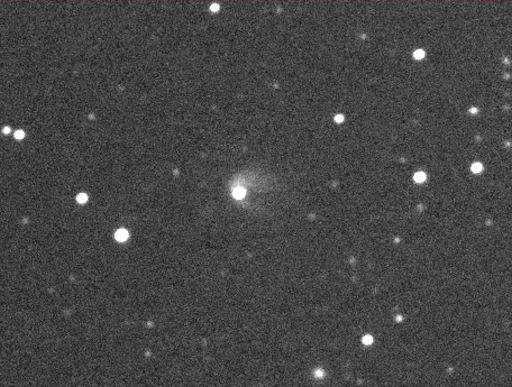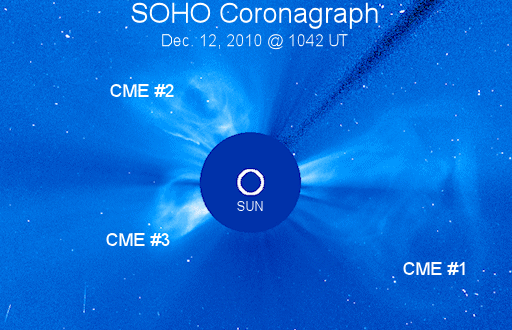GEMINID METEOR UPDATE: Spotters for the International Meteor Organization are now counting more than 30 meteors per hour as the Geminid meteor shower intensifies. On peak night, Dec. 13th-14th, forecasters expect rates to soar as high as 120 per hour for observers with dark rural skies: sky map. Got clouds? You can listen to Geminid radar echoes on Space Weather Radio.
SPIRAL ASTEROID: On Dec. 12th, the International Astronomical Union issued a telegram (CBET nr.2583) announcing the discovery of a spiral structure around main belt asteroid (596) Scheila. Steve Larson of the Catalina Sky Survey (CSS) found the curious shape in images obtained Dec. 11th through the Catalina 0.68-m Schmidt telescope. Other observers have since confirmed the phenomenon. The following picture was taken on Dec. 12th by Italian astronomers Ernesto Guido and Giovanni Sostero using a remotely-controlled 0.25m telescope in New Mexico:

What's going on? There are at least two possibilities. (1) A small asteroid might have hit 596 Scheila, raising a cloud of dust which forms a nebula around larger space rock. A 1-meter class impactor could be large enough to do the trick. (2) 596 Scheila might be a rare main belt comet, a body with the orbital characteristics of an asteroid and the physical characteristics of a comet. If so, a pocket of volatile ice might be vaporizing to produce the spiraling tail.
How the nebula or tail evolves in the days ahead could provide important clues. Amateur astronomers with experience in asteroid imaging are encouraged to monitor developments. [3D orbit] [ephemeris (enter "Scheila" in the search box)]
more images: from Charles Bell of Vicksburg, Mississippi
TRIPLE ERUPTION: Solar activity surged on Sunday, Dec. 12th, when the sun erupted three times in quick succession, hurling a trio of bright coronal mass ejections (CMEs) into space. Coronagraphs onboard the Solar and Heliospheric Observatory recorded the action:

Click here to play a 9 MB gif movie
A preliminary analysis suggests that none of the CMEs will be geoeffective. The expanding clouds should miss our planet.
Are these CMEs related? According to images from NASA's twin STEREO spacecraft and the Solar Dynamics Observatory, the clouds emerged from three distinct blast sites separated by great distances. In each case, a magnetic filament erupted--one near the sun's southeastern limb (CME#1), one near the north pole (CME#2), and one on the far side of the sun (CME#3). Because all three eruptions occcured within a matter of hours, the coronagraph images suggest a single 3-lobed cloud; in fact, they are distinct CMEs.
Stay tuned for more images and movies, in perparation.
November 2010 Aurora Gallery
[previous Novembers: 2009, 2008, 2007, 2006, 2004, 2003, 2002, 2001, 2000]
Potentially Hazardous Asteroids (
PHAs) are space rocks larger than approximately 100m that can come closer to Earth than 0.05 AU. None of the known PHAs is on a collision course with our planet, although astronomers are finding
new ones all the time.
On December 12, 2010 there were 1167 potentially hazardous asteroids.
Notes: LD means "Lunar Distance." 1 LD = 384,401 km, the distance between Earth and the Moon. 1 LD also equals 0.00256 AU. MAG is the visual magnitude of the asteroid on the date of closest approach. | | The official U.S. government space weather bureau |
| | The first place to look for information about sundogs, pillars, rainbows and related phenomena. |
| | Researchers call it a "Hubble for the sun." SDO is the most advanced solar observatory ever. |
| | 3D views of the sun from NASA's Solar and Terrestrial Relations Observatory |
| | Realtime and archival images of the Sun from SOHO. |
| | from the NOAA Space Environment Center |
| | the underlying science of space weather |

